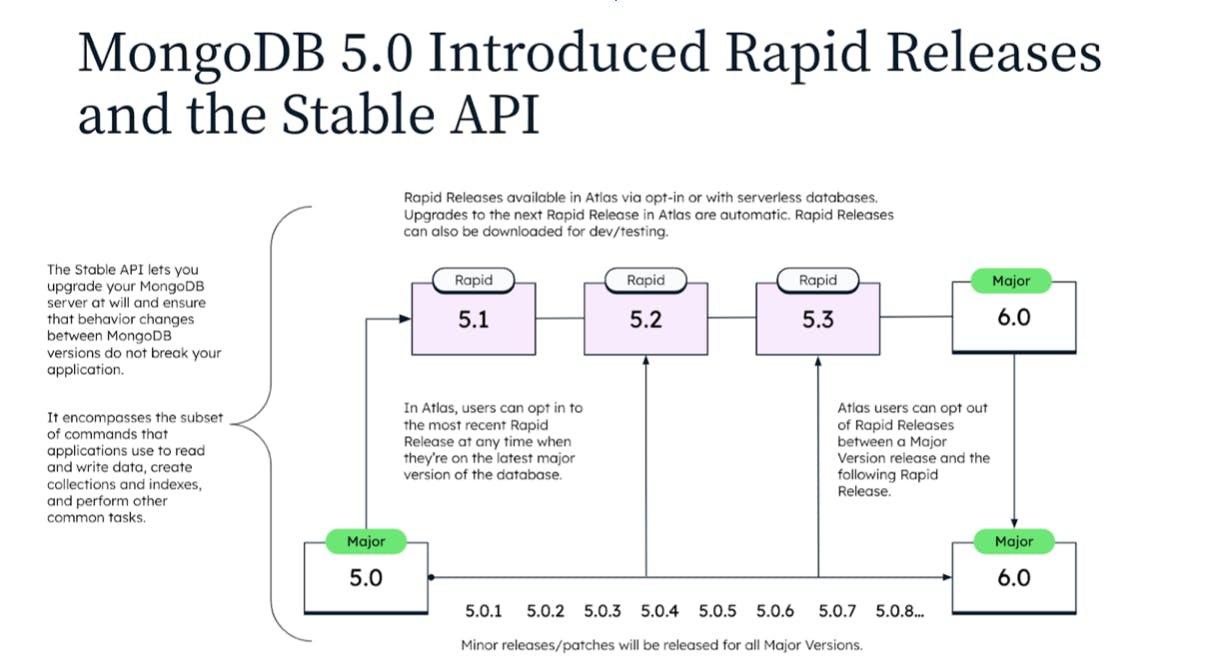Understanding the MongoDB Stable API and Rapid Release Cadence
MongoDB provides the world’s leading data platform, and we strive to make it as easy as possible for developers to build and evolve their applications. In MongoDB 5.0, we made two important updates to the way we release database versions and make them available to customers: One was the creation of the Stable API and the other was our new quarterly MongoDB Rapid Release cadence. Now that we have a few Rapid Releases under our belt (visit our blog to learn about MongoDB 5.1 and 5.2), we wanted to provide an update on the API and the process for choosing between the Major and Rapid Release tracks.
The MongoDB Stable API
The Stable API was created to make it easier for customers to upgrade to the latest MongoDB version without worrying about introducing breaking changes to their code base. It includes a subset of MongoDB commands that applications commonly use, and MongoDB ensures those commands remain consistent when we release new database versions. That effectively decouples the application lifecycle from the database lifecycle. Providing this level of consistency is especially important for helping customers consume our innovations faster and take advantage of MongoDB’s new release cadence.
It was previously known as the Versioned API, but we changed the name to Stable API to avoid potential confusion. From our conversations with users and customers, it became clear that the previous name gave the impression that the API would change with each incremental MongoDB version release. That is not the case, so we say “hello” to the MongoDB Stable API.
The MongoDB Rapid Release Cadence
MongoDB Atlas customers with clusters on a Dedicated Tier (M10+) can opt in to Rapid Releases to get the latest features from MongoDB on a quarterly basis. Atlas customers are initially on the Major Release track; Major Releases happen annually and contain the previous year’s Rapid Releases by default.
Customers who choose the Major Release track will have the following upgrade flow: 5.0 -> 6.0 -> 7.0, etc., and can schedule when they want to upgrade to each new Major Release after it enters general availability. Customers who opt in to the Rapid Release track will have the following upgrade flow: 5.0 -> 5.1 -> 5.2 -> 5.3 -> 6.0 -> 6.1 -> 6.2, etc. If you are on a Major Release and decide to change tracks, then you will automatically go to the next Rapid Release. (If you are on 6.0 and 6.2 is the latest Rapid Release, you can jump directly from 6.0 to 6.2 without having to upgrade to 6.1 first.) Customers on the Major Release track will still receive regular patch upgrades.

Users on the Rapid Release track who later decide to opt out will need to do so at the time of the next Major Release. If you’re MongoDB 5.2 and want to change back to the Major Release track, for example, you will wait to leave the Rapid Release track until the next Major Release, MongoDB 6.0, is available.
As another example, at the time of publication, the latest Major Release is 5.0 and the latest Rapid Release is 5.2. A customer on MongoDB 4.4 (an earlier Major Release prior to the new release cadence and numbering scheme) would need to manually upgrade from 4.4 to 5.0 before opting in to Rapid Releases and getting MongoDB 5.2.
To opt in to the Rapid Release cadence, choose the “Latest Release” option in the Atlas web UI. Rapid Releases are only supported for MongoDB Atlas. For on-premises environments, they should be used only for development builds and testing and not for production environments.
Apart from MongoDB Atlas Dedicated Tier clusters, Atlas supports Shared Tier clusters M0, M2, and M5 — which provide 512MB, 2GB, and 5GB of storage, respectively — as well as managed serverless instances, which are currently in public preview. Shared Tier clusters are always on the Major Release track, and serverless instances are on the Rapid Release track.
With options to get Major or Rapid Releases in MongoDB Atlas and to use the Stable API for consistency across versions, MongoDB customers have more flexibility than ever to choose how to take advantage of the latest MongoDB database upgrades. Stay tuned for the latest innovations from MongoDB in the 5.3 release this spring, and join us at MongoDB World this summer to learn about MongoDB 6.0 and more!